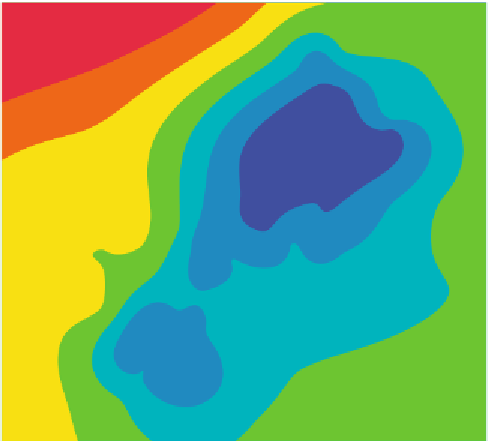Graphics Programs Reference
In-Depth Information
v = -40 : 10 : 40;
contourf(XI,YI,ZI,v)
caxis([-40 40]), colorbar, hold on
plot(data(:,1),data(:,2),'ko')
text(data(:,1)+1,data(:,2),labels)
As we can see from the plot, this method extrapolates beyond the area with
control points using gradients at the map edges (Fig. 7.9). This is in par-
ticular unwanted while gridding variables that only have positive values,
such as thicknesses of sediment beds. Such effect is particular undesired in
the case of gridded closed data, such as percentages, or data that have only
positive values. In such cases, it is recommended to replace the estimated
z
values by
NaN
. As an example, we erase the areas with
z
values larger than
20, which is regarded as an unrealistic value. The corresponding plot now
contains a sector with no data.
120
40
5
5
15
115
0
30
-15
-15
-10
-10
15
110
-20
-5
5
20
-10
-25
-15
-20
105
-25
-25
15
10
15
100
-15
-20
-10
0
-20
-20
15
-10
95
0
-20
-5
-5
-15
-15
-15
10
-10
-10
10
-10
10
-10
-10
-10
90
-15
ï
10
10
0
-5
-5
10
85
-10
-15
-20
-20
-20
-10
ï
20
-15
-15
5
80
-5
-10
15
0
-15
-15
-15
ï
30
75
0
5
15
0
5
15
5
70
ï
40
420
425
430
435
440
445
450
455
460
465
470
Fig. 7.9
Filled contours of a data set gridded using a biharmonic spline interpolation. No
control points are available in the upper left corner. The spline interpolation then beyond the
area with control points using gradients at the map edges causing unrealistic
z
estimates at
the grid points.








